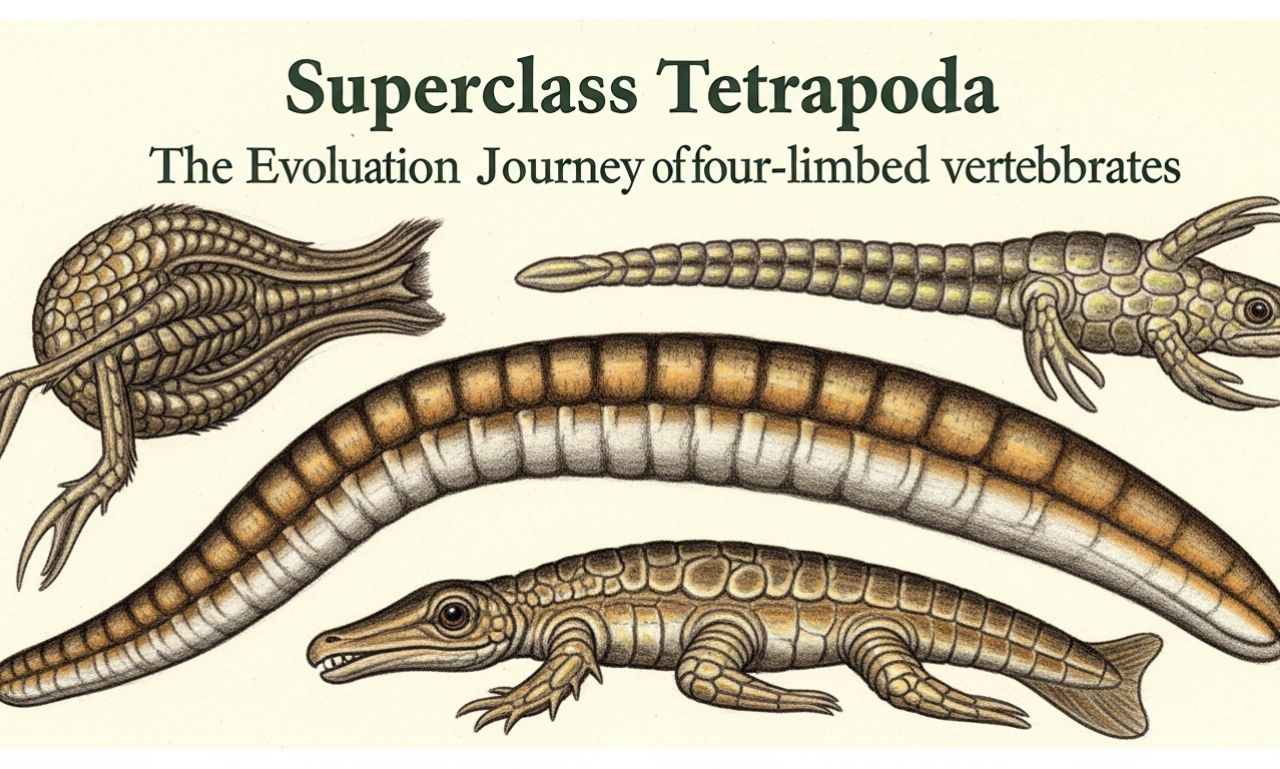The term superclass Tetrapoda refers to a vast group of vertebrate animals that includes amphibians, reptiles, birds, and mammals. The defining feature of Tetrapoda is the presence of four limbs (or evolutionary derivatives of limbs, like wings or flippers), which allowed these creatures to move from aquatic environments to land during evolutionary history.
The emergence of Tetrapoda marks one of the most significant transitions in the history of life, bridging the gap between fish and fully terrestrial vertebrates. Today, tetrapods dominate ecosystems across the globe, from the depths of the ocean to the skies above.
Evolutionary Origins
The evolution of tetrapods can be traced back around 360–400 million years ago during the late Devonian period. Early lobe-finned fishes (Sarcopterygii), particularly groups like Eusthenopteron and Tiktaalik, displayed adaptations that set the stage for the emergence of tetrapods:
-
Lobed fins that developed into weight-bearing structures.
-
Primitive lungs alongside gills for air-breathing.
-
Robust skeletal elements to support body weight in shallow waters.
Over time, these evolutionary changes enabled the first tetrapods to move onto land, giving rise to amphibians and eventually to the vast diversity of terrestrial vertebrates we see today.
Defining Characteristics
Members of the superclass Tetrapoda share a number of unifying features:
-
Four Limbs – though modified in some groups (e.g., wings in birds, flippers in whales).
-
Vertebral Column – a backbone that supports terrestrial locomotion.
-
Well-Developed Lungs – adapted for breathing air.
-
Three-Chambered or Four-Chambered Heart – depending on the class.
-
Paired Sensory Organs – including eyes and ears adapted for life on land.
While these traits vary across subclasses, they form the fundamental blueprint of tetrapod anatomy.
Classification of Superclass Tetrapoda
Tetrapoda is divided into several major classes:
1. Class Amphibia
-
Includes frogs, toads, salamanders, and caecilians.
-
Dual life cycle: most begin in water as larvae and later transition to land as adults.
-
Thin, permeable skin allows respiration but limits them to moist environments.
2. Class Reptilia
-
Includes snakes, lizards, turtles, and crocodiles.
-
Adapted for terrestrial life with scaly, keratinized skin.
-
Amniotic eggs enable reproduction away from water.
3. Class Aves (Birds)
-
Feathered tetrapods capable of flight (though some are flightless).
-
Lightweight skeleton and highly efficient respiratory system.
-
Four-chambered heart supports high metabolic demands.
4. Class Mammalia
-
Includes humans, whales, lions, and bats.
-
Characterized by hair/fur, mammary glands, and endothermy.
-
Highly developed nervous systems and diverse reproductive strategies.
Adaptations in Superclass Tetrapoda
Tetrapods have evolved remarkable adaptations that allowed them to thrive in diverse habitats:
-
Amniotic Egg – provided independence from aquatic reproduction.
-
Endothermy – found in birds and mammals, allowing survival in extreme climates.
-
Modified Limbs – wings in bats and birds, fins in aquatic mammals, elongated limbs in fast-running animals.
-
Advanced Sensory Organs – adaptations like echolocation in bats or color vision in birds.
These adaptations enabled tetrapods to occupy ecological niches ranging from deserts to polar regions.
Importance of Superclass Tetrapoda
The evolutionary success of tetrapods highlights their ecological and biological importance:
-
Dominant Terrestrial Vertebrates – shaping ecosystems across the globe.
-
Biological Diversity – from tiny frogs to massive whales, tetrapods display remarkable variety.
-
Human Evolution – humans belong to this superclass, making it central to our own evolutionary history.
-
Scientific Insights – studying tetrapods helps scientists understand adaptation, evolution, and biodiversity.
Fossil Evidence of Superclass Tetrapoda
The fossil record provides crucial insights into tetrapod evolution. Transitional fossils like Tiktaalik, Acanthostega, and Ichthyostega demonstrate the gradual shift from aquatic to terrestrial life. These fossils highlight key anatomical changes such as:
-
The development of digits (fingers and toes).
-
Stronger pelvic and shoulder girdles.
-
Enhanced respiratory systems for air breathing.
This evidence supports the theory of gradual evolution rather than sudden transformation.
Superclass Tetrapoda in Modern Ecosystems
Today, tetrapods are the most ecologically dominant vertebrates on Earth. They play vital roles in ecosystems:
-
Predators – controlling prey populations (e.g., birds of prey, big cats).
-
Herbivores – maintaining plant balance (e.g., deer, tortoises).
-
Pollinators & Seed Dispersers – many birds and mammals aid plant reproduction.
-
Indicators of Environmental Health – amphibians, for example, are sensitive to ecological changes.
Conclusion
The superclass Tetrapoda represents one of the most successful evolutionary groups in Earth’s history. From humble beginnings in shallow Devonian waters, tetrapods diversified into amphibians, reptiles, birds, and mammals, conquering land, sea, and air. Their adaptations, diversity, and ecological importance underline their central role in the story of life.
As humans, we are part of this great lineage, making the study of tetrapods not only a scientific pursuit but also a journey into understanding our own evolutionary roots.

